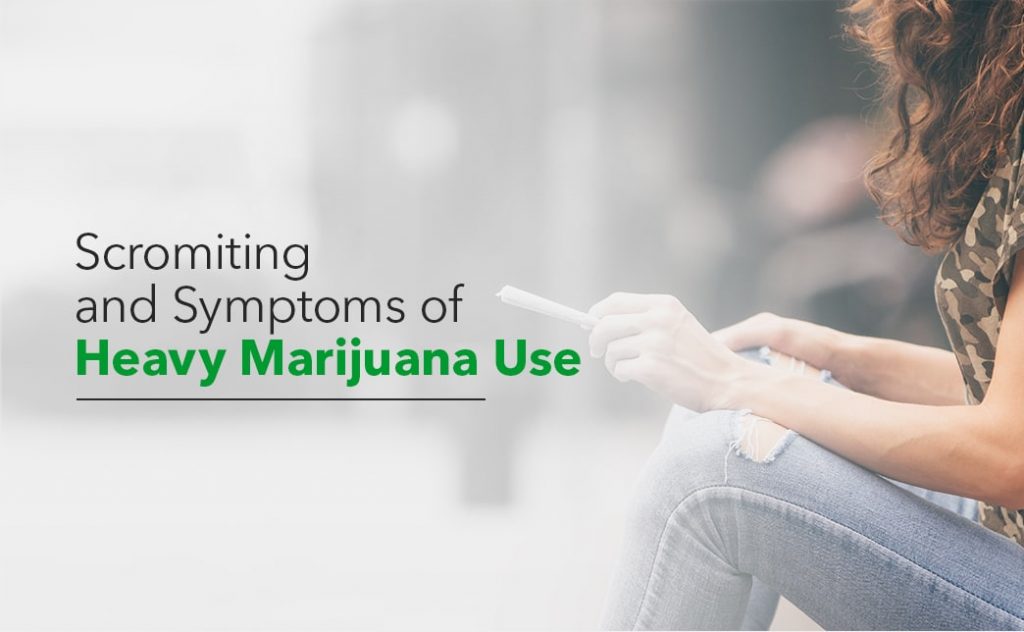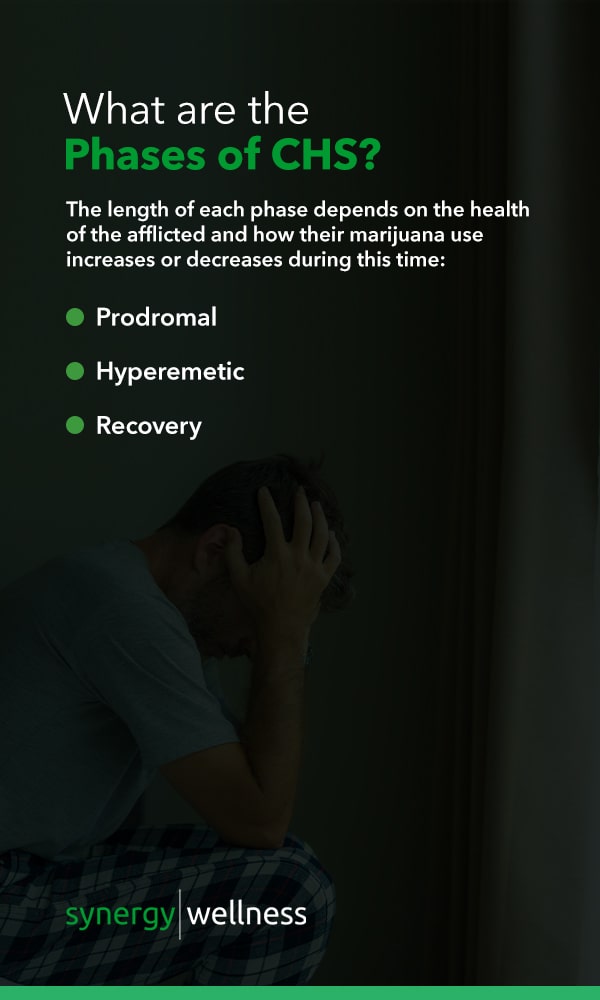
Marijuana use is becoming more and more accepted in modern society, both for medicinal purposes and for recreational use. Alongside tobacco and alcohol, marijuana is currently one of the most popular recreational drugs in the world. It’s known for inducing reducing stress and inducing euphoria — as well as an increased appetite.
While marijuana can induce feelings of relaxation and ease things such as nausea and chronic pain, as with any drug, it can have unpleasant side effects. In the short term, marijuana can create feelings of paranoia and anxiety, as well as slow reaction time and impair short-term memory. In the long term, it can lead to lung damage, brain damage and damage to the reproductive system, as well as contribute to depression and anxiety.
One lesser-known condition caused by heavy marijuana use is cyclic vomiting. Cyclic vomiting, as the name indicates, refers to episodes of severe vomiting that alternate with symptom-free periods. Because recreational marijuana use has increased, medical professionals have discovered a link between heavy use and cyclical vomiting. Specifically, they’ve discovered how heavy marijuana use can lead to cannabinoid hyperemesis syndrome (CHS), and how that links to the coarsely named “scromiting.”
What is Scromiting?
Before you learn what scromiting is, there’s something you need to know — it’s not real.
Or rather, it is real, but the term itself isn’t an official one. Scromiting is the informal name for a condition caused by the heavy, long-term use of marijuana. Those affected experience severe, repeated vomiting episodes that cycle repeatedly with symptom-free periods. These vomiting episodes are so severe that they cause the subject to scream, hence the name — scromiting is simply an amalgamation of “screaming” and “vomiting.” The term was supposedly coined by emergency room staff who began noticing patients screaming while experiencing severe vomiting.
While the cause for screaming is self-explanatory — the pain is too severe or the vomiting too constant for the patient to handle in silence— the cause of vomiting isn’t fully understood. Medical professionals know that it comes from heavy marijuana use, but the exact reason why is a mystery. It’s made all the more mysterious by the fact that marijuana can be used to alleviate nausea, especially nausea caused by cancer treatment.
Of course, the fact that it treats nausea means that sufferers of scromiting will often try to treat it with more marijuana. Unfortunately, this just makes the condition worse. And the worse the condition gets, the worse the symptoms become.

Symptoms of Scromiting
Scromiting occurs in a cycle. First, the patient begins experiencing early morning nausea, abdominal pains and vomiting. This soon advances to the next phase, where the nausea and vomiting become more severe. These episodes also become more frequent, sometimes occurring up to five times an hour. This repeated vomiting can be so painful and distressing that it causes the subject to scream. Finally, the subject enters the recovery period, where symptoms fade and the subject becomes healthy again.
The recovery period can last for a few days or as long as a few months before the cycle repeats itself. It may lull the subject into a false sense of security, but until the issue is properly treated, the cycle will eventually continue. Phases in the cycle are often triggered by increasing or decreasing marijuana use.
In the short term, scromiting causes abdominal pain, nausea, sweating, fluctuations in body temperature and vomiting. Over time, this leads to dehydration, malnutrition, weight loss and the corrosion of tooth enamel. Excessive vomiting can even tear the esophageal lining, creating what’s known as a Mallory-Weiss tear. If the condition persists, these symptoms can become fatal, or at least cause severe internal damage.
How is Scromiting Treated?
While the connection between heavy marijuana use and scromiting is not fully understood, there are several methods of treating it. Anti-nausea medicine can be useful in the short term to reduce nausea and vomiting. Hot showers or baths are also said to ease nausea and abdominal pains, so many sufferers of scromiting will take them frequently. They may also use more marijuana for its anti-nausea properties, but this will only make the condition worsen and should be avoided at all costs.
If the vomiting has become so severe that it leads to dehydration and malnutrition, those afflicted may require IV fluids to replenish lost water and nutrients. This may seem extreme, but oral methods of rehydration and nutrient replenishment won’t be effective, since the subject will simply regurgitate any food or liquids during their next vomiting cycle. An IV is the only way to assure rehydration.
Unfortunately, all of these solutions merely treat the symptoms of scromiting, and only in the short term. The subject may experience a relief period if they stop using marijuana briefly, but once they use it again, the vomiting cycle will continue. The only way to permanently stop scromiting is to stop using marijuana.

What is Cannabinoid Hyperemesis Syndrome (CHS)?
Scromiting, as stated, isn’t an official medical term. It’s simply a coarse term coined by likely tired emergency room staff. It does, however, have very real symptoms and sources. When these symptoms aren’t accompanied by screaming, then the condition can take an official name — CHS, or cannabinoid hyperemesis syndrome.
CHS, like scromiting, is a rare condition that stems from heavy, long-term marijuana use and is thought to be permanent once developed. Like scromiting, it causes a three-phase cycle of nausea, abdominal pains and heavy, repeated vomiting. It is a recently discovered condition, with the first scientific articles about it coming out in 2004. Some researchers doubted its authenticity, but once studies began, the condition became more apparent — a 2019 study showed that about 6% of emergency room visits for vomiting stemmed from CHS.
As with scromiting, the exact connection between heavy marijuana use and CHS is unknown. Some researchers believe it comes from a toxic buildup of THC in the body, while other research suggests it could stem from overstimulation of the endocannabinoid system. Regardless of the exact cause, it is a very real condition with very real symptoms, and over time can become very detrimental to those it affects.
Is CHS Serious?
Constant, severe vomiting and abdominal pain are unpleasant enough on their own, although whether or not they’re classified as serious could vary depending on the individual. However, if left untreated, the symptoms of CHS can become much worse. Due to the fact that hot baths and showers can ease nausea and abdominal pain, many sufferers of CHS develop compulsory bathing habits. This can lead to dry, itchy or irritated skin.
If left untreated, CHS can lead to severe dehydration, malnutrition and weight loss caused by both vomiting and nausea-induced food aversion. Dehydration and malnutrition can lead to further health complications, such as muscle weakness, dizziness and lightheadedness, fainting, increased rate of infection, and a weaker immune system. In extreme cases, they can cause kidney failure or be fatal.
Finally, persistent vomiting can lead to the corrosion of tooth enamel, esophageal inflammation and Mallory-Weiss tears. This is due to constant exposure to stomach acid and the strain of constant vomiting. Mallory-Weiss tears can lead to weakness, shortness of breath, chest pain and blood being present in vomit or stools. The worst part is that these conditions worsen with every vomiting cycle, and in the case of tooth enamel corrosion, are permanent.
Put simply, CHS is a serious condition, not because of its base symptoms, but because of the list of other issues that can come from it.

What are the Phases of CHS?
Similarly to scromiting, CHS cycles through three phases. The length of each phase depends on the health of the afflicted and how their marijuana use increases or decreases during this time:
- Prodromal: In this phase, the subject experiences nausea and vomiting in the early morning. They can also develop a nauseous response to food, which can cause the subject to eat less frequently. This occurs several times a week and often leads the subject to develop anxiety over the thought of vomiting. This stage can continue for days, months or even years, up until the subject increases their marijuana use to try to combat the nausea.
- Hyperemetic: Once the subject increases their marijuana use, they trigger the second phase. The nausea, abdominal pains and vomiting increase, with subjects sometimes vomiting several times an hour. They can also begin vomiting without any prior warning, which can further increase the subject’s anxiety over vomiting. The pain and vomiting can become so severe that the subject seeks medical treatment. This phase continues until the subject stops using marijuana.
- Recovery: Once the subject stops using marijuana, they enter the recovery phase. Symptoms will decrease and eventually disappear entirely, leading the subject to believe they’re cured. This phase, like the prodromal phase, can last for days to years, up until the subject begins using marijuana heavily again. Once they do, they’ll re-enter the prodromal phase and start the cycle again. The prodromal phase can also be triggered by stress, infections or menstrual cycles.
As you can see, CHS doesn’t necessarily lead to scromiting — it only does so if the hyperemetic phase is severe enough to make the afflicted scream. However, it is still an incredibly unpleasant and painful experience. When paired with how severe the symptoms can become if left untreated, it’s important to take steps to address it as soon as it becomes an issue.
How Does CHS Go Away?
Just like scromiting, there are several short-term treatments for CHS. Unlike scromiting, anti-nausea medication rarely eases the nausea of CHS. Pain-relieving medications can be useful in treating abdominal pains, however. Hot baths and showers have also been shown to reduce the symptoms shown during the hyperemetic phase. Other small studies have shown that capsaicin creams, antihistamines and even antipsychotics can provide some relief, although these shouldn’t be taken without a professional opinion.
If the subject has suffered from CHS long enough to become severely dehydrated, then IV fluids can be used to replenish water and essential nutrients. If they’re able to keep food and drink down, oral rehydration solutions can also help, although they will most likely be regurgitated during the next prodromal or hyperemetic phase.
None of these treatments will actually cure CHS, only treat the symptoms in the short term. Just like with scromiting, the only way to assure the cycle ends is to stop using marijuana. Otherwise, the issue will crop back up every time the subject uses it again. As stated, CHS is a permanent condition, so taking long breaks between marijuana usage won’t stop it from occurring.
However, if the subject has used marijuana long enough and frequently enough to develop CHS, quitting may not be so simple. Withdrawal symptoms can include anger, irritability, difficulty sleeping, appetite loss, headaches, chills and abdominal pain. In these cases, they may need to seek out addiction treatment in order to fully kick the habit and return to a healthy life.
What Does Addiction Treatment for Marijuana Do?
If you smoke marijuana several times a week, constantly think about smoking or ingesting it, have missed work or social obligations due to being high, or have been arrested or otherwise charged over marijuana or marijuana paraphernalia recently, there’s a good chance that you struggle with marijuana addiction. Addiction can stem from undiagnosed mental disorders, unaddressed adolescent trauma, unhealthy family connections and peer pressure. It isn’t a failure on the part of the individual, but rather, an unfortunate illness caused by circumstance.
That’s why, in order to overcome marijuana addiction, many individuals must turn to addiction treatment. In addition to the standard detoxification process, there are several methods of marijuana addiction treatment. Most institutes will implement a mixture of methods, including individual or group counseling, twelve-step programs, cognitive-behavioral therapy, family therapy and outpatient treatment.
Marijuana withdrawal is a thoroughly unpleasant experience. Aside from the mental compulsion and cravings, it can cause headaches, chills, abdominal pain, loss of sleep or appetite, weight loss, and more. However, prolonged marijuana abuse can have much more severe consequences, including permanent lung damage, brain damage, depression, anxiety, personality disturbances and damage to the reproductive system. As explored above, it can also lead to CHS or scromiting.
Find Treatment for Marijuana Addiction in Bakersfield, CA
While marijuana may be useful as a medicinal drug, addiction to it can have severe consequences. Among those are CHS and scromiting, two painful cyclical vomiting conditions that can lead to dangerous and even fatal health complications. The only way to cure CHS and scromiting is to quit using marijuana entirely, but doing so can be a difficult task for those struggling with addiction.
If you or someone you know is fighting with marijuana addiction, consider Synergy Recovery Services from Synergy Wellness. Synergy Recovery offers discrete, comprehensive addiction treatment through a combination of counseling and prescription medication. Our services all take place under one roof, and our team will offer the caring, therapeutic help you or your loved one needs to overcome your addiction. Contact us today to schedule a consultation or take our free addiction test, and take the first step towards recovery and a newer, healthier lifestyle.




